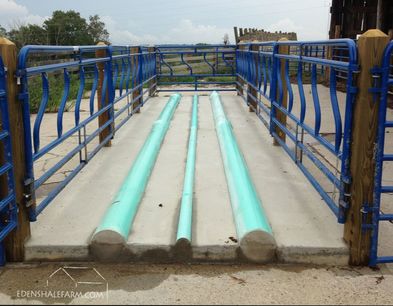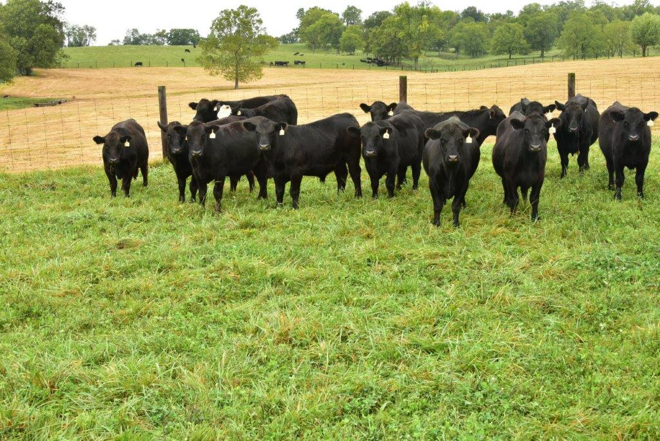 Bob Hall Bob Hall If Bob Hall has his way, he never sees a fully developed fescue seed head on his farm. The Georgetown, Kentucky, stocker operator has predominately Kentucky 31 fescue pastures. And he has experience with toxic endophyte-infected fescue and its effect on cattle. He’s heard the researchers say there’s five times more toxin in the mature seed head than in the leaves and stems. “We try not to let fescue go to seed anywhere,” Hall says. “Otherwise, the cattle get hot and stay in the shade instead of grazing.” Stocker gains go south in a big way, too — not what he has in mind. Hall will turn 350 stockers through 110 acres of pasture. It’s an eight-month grazing system, from mid-March to late November. He adds cattle as grass increases and delivers them as they hit target weight. Cattle come in weighing 600 to 625 pounds and leave at 825 to 875 pounds. “I do this all by myself, so I want healthy cattle,” he explains. Lighter calves carry more risk of health problems that might require doctoring. The cattle deal isn’t Hall’s day job. For more than 50 years, that’s been leading Hallway Feeds, Lexington, Kentucky, which specializes in equine nutrition. The company has fueled 11 Kentucky Derby winners. At home, though, Hall is the cattleman he’s been all his life, on the farm where he was raised. Last year, his stockers generated 750 pounds gain per acre. That’s a function of management. GRASS AND GRAZING MANAGEMENT While Hall’s predominant grass is KY31 fescue, those pastures also have orchardgrass and bluegrass. About every three years, he’ll frost-seed red clover at 6 pounds pure live seed per acre, typically about March 1. It costs about $20 an acre, he says, “But you can get that back several times because of the improved cattle gain.” Hall started rotational grazing about 20 years ago. He keeps the stockers in two herds, one of 65 to 70 head and another of 120 to 130. Each herd rotates through its own five or 10 pastures. Both herds have access to one more. Hall moves the cattle depending on grass growth. The big herd typically moves every three or four days; the smaller herd every six or seven days. On average, he figures 65 cattle will properly graze 1 acre per day. “If there’s 6 inches of grass left when I move, then the cattle were in there a day too long,” Hall says. “The more you leave, the quicker you can come back because the grass grows faster. “If you can’t graze a field in a week, the field is too big or you don’t have enough cattle.” That rapid rotation is Hall’s first defense against mature fescue seedheads. Intensive grazing keeps fescue seedheads from forming or, if they begin to form, allows cattle to consume seedheads early in the boot stage. At that point, seed heads are still low in toxicity. Hall wants uniform grazing across a pasture. That’s a benefit of his intensive rotational grazing — usually. “If they didn’t eat something the first time, they’re not going to eat it the next time through,” he says. “So I mow, and it’s all uniform. But, I try to put enough cattle in there so I don’t have to mow.” WEED CONTROL AND SEEDHEAD SUPPRESSION Hall’s other option for managing seed heads comes in combination with his weed control. For several years, he used Chaparral™ herbicide to control weeds and suppress fescue seed heads. “You can grow weeds or you can grow grass,” he says. “You get more gains growing grass." “The main thing you see with Chaparral is the grass stays in a vegetative state. It improves the grazing, and the grass is grazed more uniformly.” He typically applies Chaparral between April 20 and May 1, after pastures have been grazed, before boot stage. The herbicide will kill clover growth for at least the spring, but it’s a trade-off for weed control. A year after herbicide application, his clover seeding works fine. In 2017, Hall followed the herbicide application with urea fertilizer at 125 pounds per acre. “That really increased the [grass] production and made up for any clover I was going to grow,” Hall says. “I believe this will work. The grass doesn’t have a chance to get stunted, and it comes out fast.” PASTURE CONVERSION Also in 2017, Hall began the process of converting KY31 fescue pastures to novel endophyte fescue. A year earlier, he established novel endophyte fescue following soybeans on a new farm he bought. He’s used both MaxQ fescue and BarOptima Plus E34 fescue. In these new varieties, different, beneficial endophytes replace the one in KY31 that causes toxicity. Seed companies tout the new fescues for better stand persistence than endophyte-free varieties and improved cattle performance compared to KY31. To replace existing KY31 stands with the novel endophyte fescue, Hall sprayed in the spring with Chaparral™ herbicide to control weeds and suppress fescue seedheads. After summer grazing, he sprayed the fescue with glyphosate on Aug. 10 and again Sept. 1. He drilled the BarOptima into the sod soon after. “Weed control is important,” Hall says. “You want to get a field cleaned up before you go any further. Then the only thing to kill [with glyphosate] is the grass.” Hall hopes to have a stand to graze by late in the summer of 2018. He’s looking forward to it, based on his experience with his first stands following the soybeans. “I like the BarOptima a little better,” Hall says of his first stands. “It has a narrower, finer leaf that’s softer.” In 2017, Hall weighed a handful of steers after 100 days on his first stand of BarOptima. In that period, they averaged 2.9 pounds average daily gain. That’s 0.75 to 1 pound per day better compared to his KY31, he says. “They were out grazing when cattle in other pastures were in the shade,” he says. Label precautions apply to forage treated with Chaparral and to manure from animals that have consumed treated forage within the last three days. Consult the label for full details.
™®Dow Diamond and Chaparral are trademarks of The Dow Chemical Company (“Dow”) or an affiliated company of Dow Chaparral is not registered for sale or use in all states. Contact your state pesticide regulatory agency to determine if a product is registered for sale or use in your state. Always read and follow label directions.  It is March and that means one thing for Kentucky farms, mud. It’s the time of year that the spring cows are in the middle of calving season and seemingly everyday involves fighting mud to do one of two things: check the cows and calves, and feeding hay. Although March is a tough time of the year to deal with the elements, it is also the perfect time of year to make plans for managing mud in the future. While the farm is “a mess” take time to evaluate which areas are troublesome and why they are a problem. Create scenarios that may alleviate the troubled area and decide what impacts it will have on other areas. A good way to start is to think about why you do a particular practice in the first place. Is it simply the way you have always done it? Did your father and grandfather do it that way before you? Sometimes we simply need to challenge our own thinking instead of defending what we are already doing. Begin by answering simple questions like, “Do the cows have enough access to hay and water without having to travel or fight for their share?” “How much mud to they have to endure to get their daily rations?” “Are you willing to travel through the same amount of mud on foot?” In reality cows are not much different than us, in that they want to avoid mud as much as possible. If given the opportunity they will choose a route or feeding option that has less mud, which is seen as an obstacle. Research has shown that a cow traveling in as little at 8 inches of mud has an increase in energy requirements by as much as 25% to maintain the same body condition score. Every farm has areas with 8+ inches of mud, and therefore has the opportunity to increase the efficiency of that animal by reducing the amount of mud, and therefore the amount of feed that animal will require. Think about locations. Decide if your winter feeding can be done differently or in another place. Can you harden or reinforce existing areas to alleviate the amount of mud around the hay? Is your feeding location in a well drained area that will promote drier conditions? Is driving the tractor on saturated soils causing more problems than it is helping? These are all things to consider when evaluating your operation. When developing solutions to managing mud try to create efficiencies. For example, if a new feeding area is to be developed, do so in a manner that allows it to be placed close to the hay source. Can you place it in a fence row so that you don’t have to drive the tractor into the field to feed hay? Is it possible to feed multiple groups from the same location? If there are buildings on your farm, develop a plan to harvest the rainwater from the roofs to be used to water the livestock. By making your operation for efficient you can reduce your bottom line and help make your farm more profitable. Try multiple scenarios. Not everything will work the way you want it to. As you try new methods you will find things that work and they will lead to other practices that pair and work well together. By doing this over time you slowly create a new system that may look completely different from your original model. It all starts with recognizing a problem and questioning how and why you do it. This is the process that we have worked through at Eden Shale Farm. Questioning why, and then coming up with new solutions. But let me say this, by no means have we eliminated mud on our farm. We are simply attempting to manage the mud. We control when the cows are exposed to mud and move them to areas that have been improved during times of highest stress (i.e. end of the winter, and calving season, etc). This allows the cattle to experience less stress due to environmental factors. If you would like to see some of the improvements that have been made at Eden Shale Farm, check out the blog at www.edenshalefarm.com or contact us for tour opportunities at 859-278-0899 or [email protected]. |
Archives
June 2024
Categories
All
Welcome |
CONTACT US |
EMAIL SIGN UP |
|
Eden Shale Farm
245 Eden Shale Rd. Office: (859) 278-0899 Owenton, KY 40359 Fax: (859) 260-2060 © 2021 Kentucky Beef Network, LLC.. All rights reserved.
|
Receive our blog updates
|


 RSS Feed
RSS Feed
